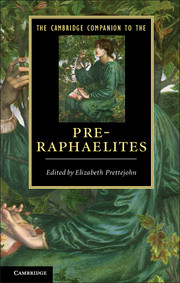Book contents
- Frontmatter
- Introduction
- PART ONE PRE-RAPHAELITISM
- PART TWO PRE-RAPHAELITES
- 6 The poetry of Dante Gabriel Rossetti (1828–1882)
- 7 The painting of Dante Gabriel Rossetti
- 8 William Holman Hunt (1827–1910)
- 9 John Everett Millais (1829–1896)
- 10 Ford Madox Brown (1821–1893)
- 11 Christina Rossetti (1830–1894)
- 12 Elizabeth Eleanor Siddall (1829–1862)
- 13 The writings of William Morris (1834–1896)
- 14 The designs of William Morris
- 15 Edward Burne-Jones (1833–1898)
- 16 Algernon Charles Swinburne (1837–1909)
- 17 William Michael Rossetti (1829–1919)
- 18 Envoi
- Appendix 1 The contents of The Germ
- Appendix 2 The Pre-Raphaelite ‘list of Immortals’
- Guide to further reading and looking
- Cambridge Companions to …
- Index
8 - William Holman Hunt (1827–1910)
from PART TWO - PRE-RAPHAELITES
Published online by Cambridge University Press: 28 September 2012
- Frontmatter
- Introduction
- PART ONE PRE-RAPHAELITISM
- PART TWO PRE-RAPHAELITES
- 6 The poetry of Dante Gabriel Rossetti (1828–1882)
- 7 The painting of Dante Gabriel Rossetti
- 8 William Holman Hunt (1827–1910)
- 9 John Everett Millais (1829–1896)
- 10 Ford Madox Brown (1821–1893)
- 11 Christina Rossetti (1830–1894)
- 12 Elizabeth Eleanor Siddall (1829–1862)
- 13 The writings of William Morris (1834–1896)
- 14 The designs of William Morris
- 15 Edward Burne-Jones (1833–1898)
- 16 Algernon Charles Swinburne (1837–1909)
- 17 William Michael Rossetti (1829–1919)
- 18 Envoi
- Appendix 1 The contents of The Germ
- Appendix 2 The Pre-Raphaelite ‘list of Immortals’
- Guide to further reading and looking
- Cambridge Companions to …
- Index
Summary
whilst I was painting ... in Rossetti‘s studio, there entered the greatest genius that is on earth alive, William Holman Hunt – such a grand-looking fellow, such a splendour of a man, with a great wiry golden beard, and faithful violet eyes – oh, such a man.
So wrote Edward Burne-Jones in 1856, eight years after the formation of the Pre-Raphaelite Brotherhood. Hunt was only twenty-nine and Burne-Jones's breathless words show us that, like a modern celebrity, his activities were mythologized as they occurred. All accounts of Hunt's career, then and since, participate in this, but it is notable that the nineteenth-century concept of ‘genius’, defiant originality and physical daring, remains recognizable today.
Hunt's art is best summarized as addressing extremes: both signification and representation are taken to their absolute limit. His readiness to adapt and combine narratives and allusions from all sorts of texts, ancient and modern, pioneered a newly intense pictorial poetry. At the same time, on the same canvases, investigations into artistic vision and experiments in technique tested optical representation, and understandings of beauty and truth were redefined. Hunt's success was won and maintained outside the establishment. His radical self-stylization created a new kind of artist/hero and confronted the problem of the role of art in a global, capitalist culture. This was, however, only one aspect of his broader preoccupation with the predicament of the individual within a modern, mass, materialist society. Hunt's paintings and writings return again and again to the idea of the subjective experience of the lover, the outsider or the leader in tension with the collective values of family, establishment and crowd.
- Type
- Chapter
- Information
- The Cambridge Companion to the Pre-Raphaelites , pp. 116 - 132Publisher: Cambridge University PressPrint publication year: 2012

